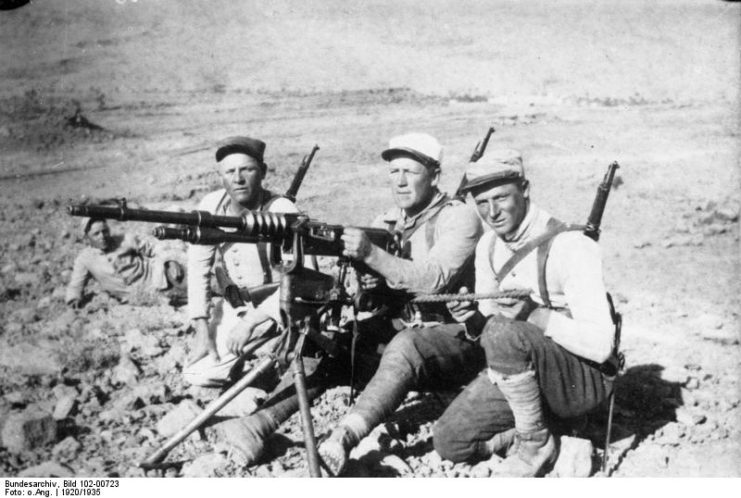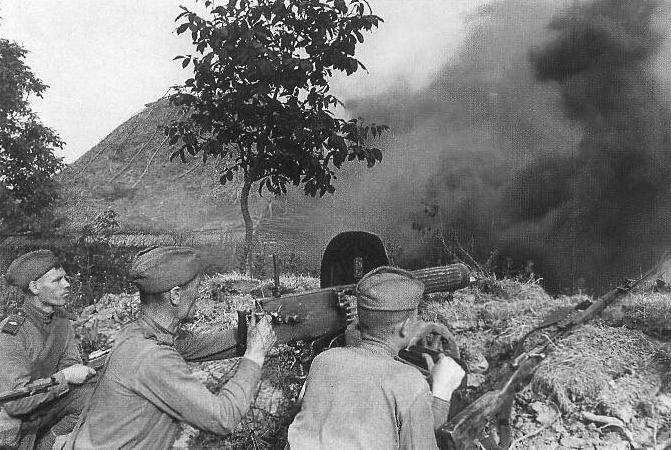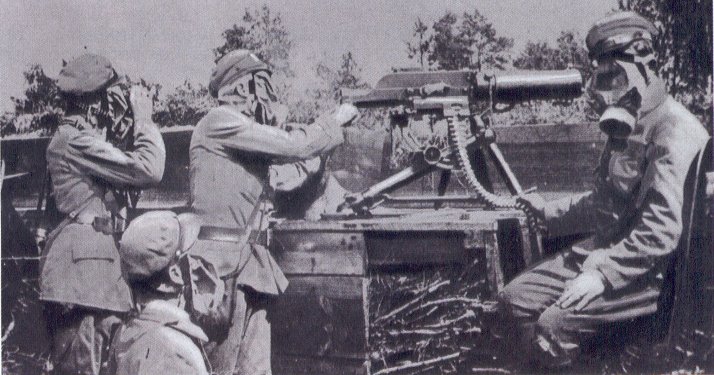The heavy machine-gun was the defining weapon of WWI. It’s devastating firepower wiped out entire units of infantry in moments, halting the offensives that the generals had expected to define the war. Instead, infantry cowered in their trenches, keeping their heads down to avoid the deadly hail of lead.
These are the weapons which shaped that war.
Hotchkiss Model 1910
In 1893, the Hotchkiss arms manufacturing company bought the rights to a gas-powered machine-gun designed by the Austrian Baron Adolf von Odkoek. Adapting the baron’s flawed but innovative design, they created a series of Hotchkiss machine-guns which became a vital part of the French arsenal. Its unique feature was an ammunition feed system which used metal strips of 24 or 30 rounds.
Having adopted the Hotchkiss, the French repeatedly tinkered with the design, creating ever-better models. The 1910 model, with which they entered the war, was air-cooled using five metal donut shapes that ran around the barrel near the receiver. They absorbed the heat on firing the weapon and then radiated it off using their large surface area. Air cooling made the gun easier to carry around than conventional water-cooled machine-guns, although it was still used in the same way.
Hotchkiss Model 1914
The Hotchkiss Model 1914 was almost the same as the 1910 one. It’s firing mechanisms were the same, as was the innovative cooling system.
The most substantial difference was the ammunition feed. A semi-articulated belt carried 249 rounds in three-round links. It made loading easier, and so increased the speed of fire. Its rate of fire was between 400 and 600 rounds per minute.
The Hotchkiss feed system proved to be unreliable, but the rest of the design was sound. Demand for the guns remained high throughout the war. It rose again when America entered in 1917. The Americans were the last global power to embrace machine-guns wholeheartedly and needed large supplies at short notice. For many of their weapons, they turned to Hotchkiss.

Vickers Mk I
The Vickers Mark I was the leading British machine gun of the war. Although it entered service in 1912, it was developed from an older design – the Maxim gun of 1884.
In creating a mass production model of the Maxim, the British made several adjustments. The main effect of them was to make the weapon lighter while retaining its durability and 450-500 rounds per minute rate of fire.
The Vickers was water cooled and could continue firing almost indefinitely as long as it was supplied with a steady stream of water. The seven pints held in its jacket would boil and steam off with just three minutes of continuous fire, so condenser systems were added to avoid the giveaway jets of steam.
Even with the water coolant, barrels quickly became worn. They had to be replaced every 10,000 rounds which could easily be achieved in an hour during a heavy engagement. Speedy barrel changes became a vital skill for those operating the Vickers guns.
Pulemet Maxima 1910
Also based on the Maxim, the Pulemet Maxima 1910 was the standard Russian heavy machine-gun. It had a steel water jacket instead of a bronze one and was around 30% heavier than the Vickers. The Russians often mounted it on a small carriage with shielding to protect the gunner.
Although heavy and expensive to make, the Pulemet ideally suited the needs of the Russian army. While most machine guns of the era were considered obsolete by WWII, the Pulemet remained in production until 1943. It was a testament to its reliability and importance to the Russians in retaining such a weapon.

Maschinengewehr 08
A powerful and reliable weapon, the Maschinengewehr 08, or MG08, was the German weapon of choice. Although it was capable of firing 600 rounds per minute, the Germans kept the cycle rate down to 300-450 rounds per minute, as they believed in the importance of aiming, rather than purely massive firepower. The approach helped to keep down ammunition consumption and reduced the rate at which barrels had to be replaced.
An estimated 90% of British casualties on the first day of the Battle of the Somme fell to this weapon.
Schwarzlose Maschinengewehr Model 1912
This Austro-Hungarian heavy machine-gun was not as impressive as its British and German counterparts. Water-cooled and powered by a delayed blowback mechanism, it was an adequate weapon. However, its muzzle velocity was lower than that of the leading guns, and it had a rate of fire of only 400 rounds per minute.
One of the biggest flaws with the Schwarzlose was the length of the barrel. It was slightly too short for its rounds, leading to a bright muzzle flash that could give away its location to enemy gunners.

Colt-Browning Model 1895
Despite being less interested in machine guns than their peers, the Americans had their own model.
The Colt-Browning Model 1895 was air-cooled and gas-operated. It had a pistol-grip handle, a distinct feature of American weapons of the era.
At the start of the 20th century, the American military expected to be engaging in colonial-style warfare as the European nations did. They thought the Colt-Browning 1895 would be adequate. On entering WWI, they discovered they had misjudged the situation. Only a few of the guns saw action in Europe.
Machine-Gun M1917
In 1895, Browning began work on a successor to the model of that year, but without interest from the military, the plans were shelved.
Suddenly needing to mass-produce modern weapons, in 1917 the design was resurrected and updated, becoming the M1917. With a cycle rate of 450-600 rounds per minute, relatively light weight and decent power, it was a suitable weapon for the war. It was reliable despite being rushed into production, thanks to the skill of the designer John Browning.
Sources:
Christopher Chant (1986), The New Encyclopedia of Handguns
Ian Westwell (2008), World War I
